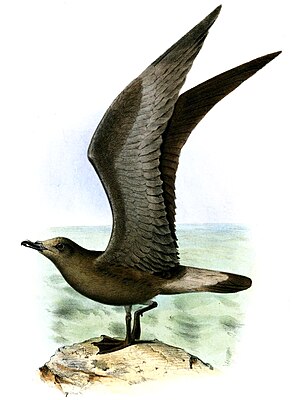Jamaican petrel
| Jamaican petrel | ||||||||||
|---|---|---|---|---|---|---|---|---|---|---|

Jamaican petrel ( Pterodroma caribbaea ) |
||||||||||
| Systematics | ||||||||||
|
||||||||||
| Scientific name | ||||||||||
| Pterodroma caribbaea | ||||||||||
| Carte , 1866 |
The Jamaican Petrel ( Pterodroma caribbaea ) is probably extinct species of bird in the family of the petrels . Occasionally it is considered a subspecies of the devil petrel ( Pterodroma hasitata ). The few known museum specimens come from the region of the Blue Mountains in Jamaica .
features
The Jamaican petrel reached a size of 40 centimeters. The wing length was 267 to 284 mm, the beak length 29.1 to 32.6 mm, the barrel length 34.0 to 36.6 mm and the tail length 107.1 to 119.9 mm. The Jamaican petrel looked very much like the devil petrel. The plumage was more or less a single color soot-brown. The reins, the throat and, in some specimens, the lower abdomen were lighter than those of the Devil's Petrel. The rump and the upper tail covers were latte brown. The beak, legs and feet were black. The eyes were dark.
Way of life
Little is known about his way of life. It was most likely nocturnal, breeding in colonies in the mountain forests of the Blue Mountains and John Crow Mountains in eastern Jamaica at altitudes up to 1,600 m. The mating and breeding season was between October and December. Like most petrels, this species probably only laid one egg. The clutch was in crevices in the cliff or in caves under trees.
status
When it was discovered in 1789, the Jamaican petrel was still described as common. Even Philip Henry Gosse reported in 1847 about the existence of these petrels, he was not able to supply able to provide a description of the nature. In 1866 two copies were collected, which served as the basis for the first scientific description. The last documented evidence of the Jamaican petrel was between November and December 1879, when the English gardener William Nock cleared areas of forest in the Blue Mountains for the cultivation of cinchona bushes. 22 specimens of the Jamaican petrel were shot during this period, 8 of which are in the University Museum of Zoology in Cambridge, Massachusetts. During a search expedition in 1891, the ornithologist William Earl Dodge Scott was unable to find any more specimens, but several mongooses. At the same time, Scott suggested that the Jamaican petrel could still be found in the John Crow Mountains. After further searches failed, it was described by Frederick DuCane Godman in his monograph "Monograph of the Petrels" (1907-10) as almost extinct. Carl Eduard Hellmayr and Henry Boardman Conover listed the species as extinct in their 1948 work "Catalog of birds of the Americas". In 1965 ornithologist William Bourne reported rumors of petrels in the John Crow Mountains. Search expeditions followed in the 1970s and 1980s and between 1996 and 2000, but all of them were unsuccessful. The main reasons for the disappearance of the species are considered to be overhunting (up to the middle of the 19th century) and stalking by rats, mongooses and pigs. BirdLife International classifies the Jamaican petrel in the critically endangered (believed to be extinct) category .
Systematics
Even before it was first described scientifically in 1866, this bird was mentioned by Patrick Browne in his work Natural History of Jamaica in 1789 . The species was known by the locals as the "Blue Mountain Duck". In 1936, the Jamaican petrel was regarded by Robert Cushman Murphy as the color morph of the petrel . In 1991 ornithologist Mike Imber suggested that the Jamaican petrel was more closely related to the Cape Verde petrel ( Pterodroma feae ) and classified it as a separate species.
Individual evidence
- ^ Douglas, L. (2000) Status of the Jamaican Petrel in the West Indies. Pp. 19-24 in Schreiber, EA and Lee, DS (Eds.): Status and conservation of West Indian seabirds. Ruston, USA: Society for Caribbean Ornithology.
- ^ Bourne, WRP 1965. The missing petrels . Bulletin of the British Ornithologists' Club 85: 6.
- ^ Robert Cushman Murphy: Oceanic Birds of South America. Vol. II. Macmillan, New York, 1936
- ^ Imber, MJ (1991) The Jamaican Petrel - Dead or Alive ?. Gosse Bird Club Broadsheet 57: 4–9.
literature
- Michael Brooke: Albatrosses and Petrels Across the World . Oxford University Press, 2004, ISBN 0-19-850125-0 .
Web links
- BirdLife Species factsheet
- Pterodroma caribbaea inthe IUCN 2012 Red List of Threatened Species . Listed by: BirdLife International, 2012. Retrieved November 17, 2012.